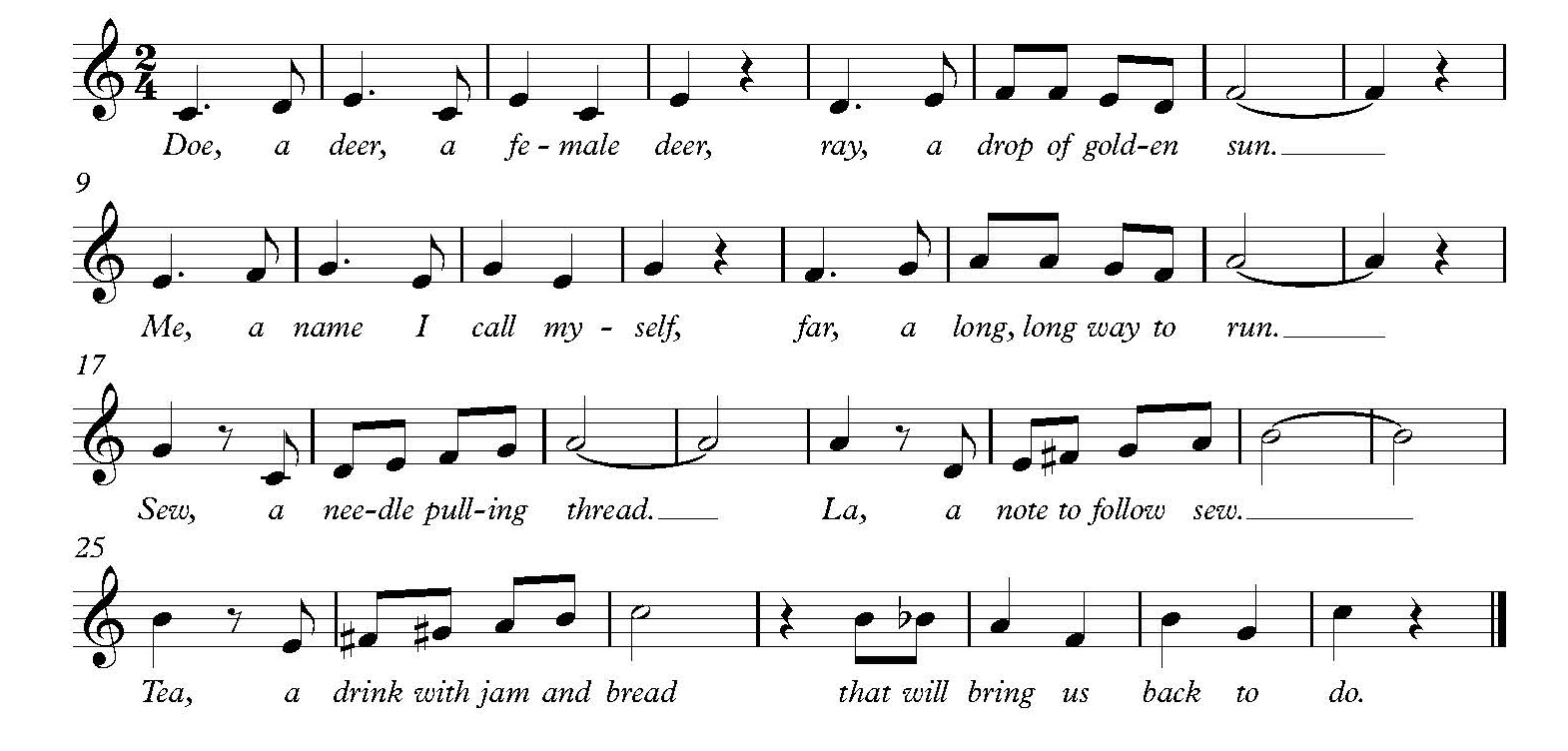Lesson 1: Learning “Do-Re-Mi”
Aim: How can we explore a musical scale while learning about musical theater?
Summary: Students learn to identify and sing the scale in “Do-Re-Mi” while understanding the genre of musical theater.
Materials: Musical Explorers CD or online audio, scissors
Standards: GA: ESGMK-2.CR.1; ESGMK-2.CR.2; ESGMK-2.CR.3; ESGMK-2.PR.1; ESGMK-2.PR.3; ESGMK-2.RE.1; ESGMK-2.RE.3; ESGMK-2.CN.1
SC: MGK-2.1, MGK-2.3, MGK-2.4, MGK-2.5, MGK-2.6
Vocabulary: musical, pitch, solfège, scale
Sing “Do-Re-Mi”
- Warm up your students’ voices and bodies using the warm-ups on pages.
- Listen to “Do-Re-Mi,” Track 18.
- Learn to sing the chorus, Track 19.

“Do-Re-Mi” by Richard Rodgers and Oscar Hammerstein II. Copyright © 1959 by Richard Rodgers and Oscar Hammerstein II. Copyright Renewed. Williamson Music (ASCAP), an Imagem Company, owner of publication and allied rights throughout the World. International Copyright Secured. All Rights Reserved. Used by Permission.
- Invite students to describe what they hear in the music.
- Explain that “Do-Re-Mi” comes from a musical called The Sound of Music by Richard Rodgers and Oscar Hammerstein. A musical is a performance that combines songs, spoken words, acting, and dancing.
- What are some musicals you already know? Let’s make a list (e.g. Annie, The Lion King, Peter Pan, Hamilton).
- If students have never seen a musical performed live on stage, remind them that they may have seen a movie musical before (e.g. Coco, Moana, Frozen).
- The Sound of Music is a musical about a nun who becomes a governess (nanny) and takes care of seven children. She teaches the children to sing and they learn to love her.
- Listen again to “Do-Re-Mi” and encourage students to sing along and tap the steady beat on their body along with the music.
Explore Hand Signs and Solfège in “Do-Re-Mi”
- Solfège (SOL-fehj) is a musical language that helps us learn to sing melodies.
- Solfège is like the alphabet for music!
- In music, pitch is a way of talking about how high or low a note is. Pitches can be organized into a musical scale, or pattern of notes. Solfège syllables are the names for each note in a musical scale. In the song “Do-Re-Mi,” J.J. sings the seven solfège syllables in a major scale: DO, RE, MI, FA, SOL, LA, and TI.
- Using SG30, teach students the solfège hand signs that can go along with a major scale.
- Practice hand signs while listening to the song. Challenge students to memorize one hand sign each time you listen.
- Students can perform their signs “on stage” in front of the class. Encourage proper performance etiquette from the audience: when other students are performing, the class should listen and pay attention, and show their appreciation with applause at the end of the performance.
Optional: Show students the original version of “Do-Re-Mi” from The Sound of Music on YouTube. Encourage students to sing along.
Explore Solfège and Scale in “Do-Re-Mi”
- Using SG31, cut out the cards containing the pictures for DO, RE, MI, FA, SOL, LA, TI, and DO. Ask students to listen for the solfège syllables and hold up each one as they listen. Then, encourage students to create a “ladder” on their desks or the floor with big DO at the bottom and small DO at the top as they sing “Do-Re-Mi.” Discuss the opposites of high/low and up/down.
- Challenge your students to build the ladder once from memory. Then, ask them to check for accuracy while they listen.
Creative Extension: Explore Melodies in Solfège
Using the hand signs on SG30, explore familiar melodies. First, sing the melody in solfège and ask students to guess the lyrics. Sing “Twinkle, Twinkle, Little Star” and “Rain, Rain.” Try to use the hand signs as you sing.
Musical Word Wall
Add the words musical, pitch, solfège, and scale to the Musical Word Wall.
PDF Downloads
SG30 ↓ Download File
SG31 ↓ Download File
Musical Explorers Audio Tracks
